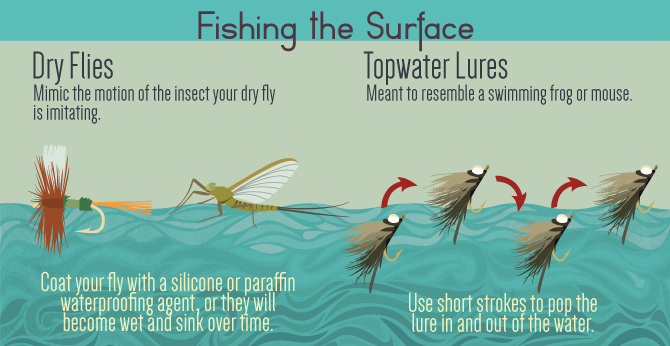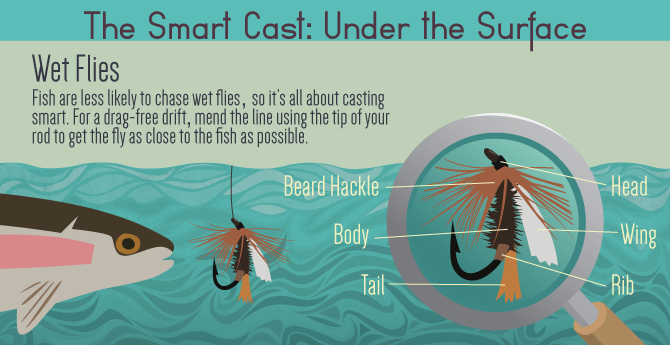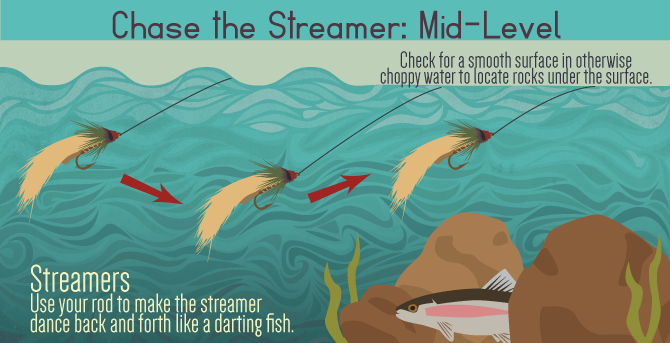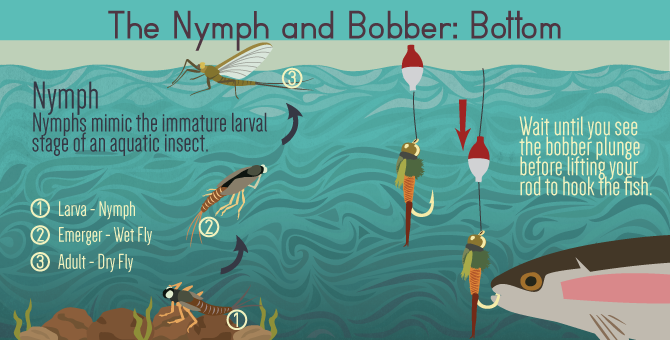![]() It’s an iconic image that’s featured amidst many people’s Northern cabin decor: a fishing lure featuring feathery tufts that represent the wings of an insect. This icon of fly fishing is a type of lure called a “dry fly.” Fly anglers use dry flies to imitate insects hatching on the top of rivers. The trout cannot resist.
It’s an iconic image that’s featured amidst many people’s Northern cabin decor: a fishing lure featuring feathery tufts that represent the wings of an insect. This icon of fly fishing is a type of lure called a “dry fly.” Fly anglers use dry flies to imitate insects hatching on the top of rivers. The trout cannot resist.
But that’s not the only way to fly fish and trout aren’t the only kind of fish you can fool with a fly. Rivers aren’t the only place you can fly fish. And dry flies aren’t the only kind of tackle you can use.
Sure, an angler’s fly box is comprised of a large number of surface flies. But tucked away in there might also be flies that imitate all stages of a bug’s life, as well as flies that look like little baitfish, frogs, and even mice to satiate the appetite of the biggest bass and trout in the lake or river. Each of these types of flies is used in a different part of the water column–and even in different bodies of water. Let’s start from the bottom of the water column and work our way up.
Dry flies
Dry flies imitate the adult stage of a fly. A good trout hatch consists of a single species of fly hatching at the same time. Trout do most of their feeding along the bottom of rivers, but a good hatch will move them to the surface of the water. One of the earliest spring hatches on trout streams is called the Hendrickson (a type of mayfly) hatch. Mayflies are unusual in that they only live about a day after they become adults. The adult insects don’t even have mouth parts: they don’t live long enough to eat. But trout do.
Dry flies usually consist of a soft body with tufts of feathers or fur tied to resemble wings. Anglers target trout that are feeding in a consistent pattern, which you can see by viewing the rings their mouths are making on the surface of the water. Drift your fly over the lane in which your targeted fish is feeding and you may hook it. You’ll be in for a ride.
For a particularly good time, use flies that resemble spiders, ants, or other terrestrial critters during the bluegill’s spawning time in lakes and ponds. Bluegill are eager eaters, and bigger bluegill can be a fun fight on a fly rod.
Topwater Lures
One of the biggest rushes an angler can experience is hearing – but not necessarily seeing – a big brown trout slashing at your fly in the middle of the night. Brown trout are good hunters, and will eat whatever might be swimming across rivers at night, even mice or frogs. Anglers fish with flies tied to resemble mice on dark nights. These flies are fished with short, twitchy, slow retrievals, imitating the movement of a mouse swimming across the surface of the water.
Topwater flies can also be used for bass. Called poppers, these flies have what looks like a wide mouth with a fur or feather tail. Strip these flies back to you in short motions that cause the mouth of the fly to dig into the water, then pop back up. This can resemble the motion of a frog – and might just attract the attention of curious bass. Anglers also use them for redfish in salt flats and marshes along the ocean coasts.
Wet Flies (Emergers)
The lifecycle of a nymph depends on the time of year. After a certain amount of light and heat, nymphs begin to mature. They will migrate up through the water column, eventually popping out on the surface of the river as mature flies with legs and wings. As they swim up through the water column of the river, they can attract the attention of trout, and become lunch. Wet flies mimic this stage, and are often dangled just below the surface of the water. They look like the nymph fly with the addition of a hackle wound around them and sometimes feature an emerging wing. The hackle moves gently with the water’s current, resembling the motion of a nymph’s legs.
Streamers
Streamers are flies meant to be fished below the surface of the water. Resembling minnows or other small baitfish, they are often tied with a weighted head so they dip down in the water better. The weighted head is either cone-shaped or shaped like a small barbell and the ends of the barbells are often painted like eyes. When you fish a streamer, you cast across the river or against a structure in a lake. You draw the streamer back to you in small, smooth jerks, dancing the streamer along like a darting fish.
Fishing guides will say lighter-colored streamers work better on sunny days and darker streamers work better on cloudy days. Cloudy days tend to be better for fishing. Aim for downed trees or large boulders, which provide a break in the river’s current or shelter from a lake’s predators, and are places fish like to lurk.
You can use streamers for a variety of fish: brown trout, rainbow trout, or bass in rivers and lakes. Streamers tied to resemble crayfish tempt both bass and carp. Walk these streamers along the bottom of the lake with slow, crab-like twitches. Along the ocean’s coasts, anglers fish the salt flats with streamers and target redfish, bonefish, snook, and tarpon.
In warmer rivers, anglers target pike and muskellunge. Pike can be eager eaters, but muskies are often called “the fish of 1,000 casts” because it can take some persistence to catch one.
Nymphs
Trout like to lie along the bottom of rivers in deep, dark pockets of water. There, they can wait until their lunch floats to them, mostly in the form of aquatic invertebrates. These invertebrates are often nymphs, or the larval stage of insects. And so one way to catch trout is to use a fly called a nymph. A nymph fly is typically comprised of a weighted bead head with a fur or feather body. To successfully fish with nymphs, anglers drift the nymph along the bottom of the river. An object that floats along the surface of the river buoys the nymph: either a bobber, or another, larger fly that can float the nymph’s weight. When that bobber dips down into the water, it might mean you have a fish on – or you have encountered some of the woody debris or one of the boulders that so often line the bottom of rivers.
Which type of fly works best depends on which region you are fishing, and what the fish are used to eating. If you’re fishing a particular hatch, matching your fly to the hatch is a good idea. Use a dry fly that’s approximately the same size, color, and profile as the fish that are hatching. Streamers in different sizes and colors are helpful when you’re targeting larger river fish or fish in lakes or salt flats.
But most helpful is just being out on the water, testing your skills, the kind of flies you offer, and the way you use them.
Complete article from Fix.com




